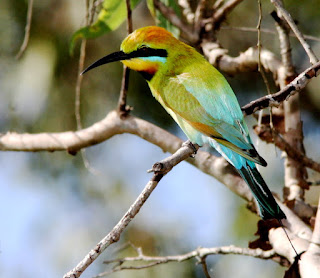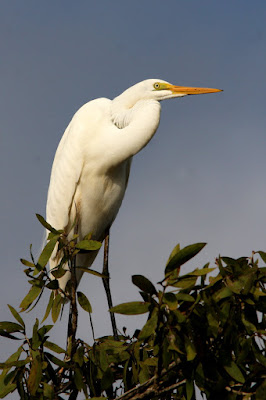Toured down my favourite country road today with flash new flash and hopes of finding Lemon-bellied Flycatcher (Microeca flavigaster) in coastal woodland. Bird turned up briefly. Flash failed, then overcompensated.
Did better unflashed with Blue-winged Kookaburra (Dacelo leachii) glaring down from distant height.
Better yet with flashy unflashed Brahminy Kite (Haliastur indus) sitting unruffled by gusty winds and my approach on foot.
More flash on this Rainbow Bee-eater (Merops ornatus). Like bird's surroundings, flash new flash rather complicated.
Friday, July 30, 2010
Wednesday, July 28, 2010
Slough puts snake at risk
Came upon this Red-bellied Black Snake (Pseudechis porphyriacus) coiled on track in short grass yesterday.
Too open and hazardous a spot for a species usually extremely alert and sharp-eyed.
Though no sign elsewhere about body, slough seems to have begun at the eyes.
Snake senses me though it cannot see well, if at all. A gentle push with small stick encouraged it into safer cover.
Too open and hazardous a spot for a species usually extremely alert and sharp-eyed.
Though no sign elsewhere about body, slough seems to have begun at the eyes.
Snake senses me though it cannot see well, if at all. A gentle push with small stick encouraged it into safer cover.
Monday, July 26, 2010
Golden, tawny, or browned off?
Bird names can be somewhat colourful. Is this Golden-headed Cisticola (Cisticola exilis) - on the alert amid scleria - really so golden?
Was someone on the mark or on the port in naming the Tawny Grassbird (Megalurus timoriensis)?
The birds may look alike, because they share grassland habitat, but the small Cisticolas tend to avoid the shaded branchy bushes the bigger Tawnys go to when disturbed. Further to my point, Tawnys always sound browned off.
Was someone on the mark or on the port in naming the Tawny Grassbird (Megalurus timoriensis)?
The birds may look alike, because they share grassland habitat, but the small Cisticolas tend to avoid the shaded branchy bushes the bigger Tawnys go to when disturbed. Further to my point, Tawnys always sound browned off.
Saturday, July 24, 2010
Cormorants hunt as pack, eat alone
About 20 Little Black Cormorants (Phalacrocorax sulcirostris) dominate the fishing in Tyto's new lagoons these days.
Birds hunt in a pack, often diving and resurfacing in near unison.
But togetherness stops at sharing the spoils. Taking the catch ashore is best strategy.
Get the fish lined up head-first for the swallow.
In it goes, ready for the final gulp. Then, quickly back to rejoin the pack.
Birds hunt in a pack, often diving and resurfacing in near unison.
But togetherness stops at sharing the spoils. Taking the catch ashore is best strategy.
Get the fish lined up head-first for the swallow.
In it goes, ready for the final gulp. Then, quickly back to rejoin the pack.
Thursday, July 22, 2010
Cuckoo-shrike sets the tone
White-bellied Cuckoo-shrike (Coracina papuensis) lines up near Tyto info centre early today.
Grey start leads to White-breasted Woodswallow (Artamus leucorynchus) from the holdover file.
Little bit brighter, male Varied Triller (Lalage leucomela), also from holdovers.
Finally, touch of sunshine this week, on Fairy Gerygone (Gerygone palpebrosa). Hard to capture these fast-moving little birds, usually high in crowded foliage.
Grey start leads to White-breasted Woodswallow (Artamus leucorynchus) from the holdover file.
Little bit brighter, male Varied Triller (Lalage leucomela), also from holdovers.
Finally, touch of sunshine this week, on Fairy Gerygone (Gerygone palpebrosa). Hard to capture these fast-moving little birds, usually high in crowded foliage.
Tuesday, July 20, 2010
Honeyeaters feel the weather
Juvenile Brown Honeyeater (Lichmera indistincta) with temporary crest courtesy of strong winds that have persisted lately. Happily, though mornings are clouded more often than not, blue-sky days should soon settle upon us.
Certainly this Yellow Honeyeater (Lichenostomus flavus) on tulip tree seed pod in Tyto yesterday seemed happy in late afternoon warmth.
Pair of Red-backed Fairy-wrens (Malurus melanocephalus) pause during mutual preening session. Tried without luck for more loving interaction between birds but one or other would always turn away.
Agile Wallaby mother and young show a bit more togetherness for the camera.
Certainly this Yellow Honeyeater (Lichenostomus flavus) on tulip tree seed pod in Tyto yesterday seemed happy in late afternoon warmth.
Pair of Red-backed Fairy-wrens (Malurus melanocephalus) pause during mutual preening session. Tried without luck for more loving interaction between birds but one or other would always turn away.
Agile Wallaby mother and young show a bit more togetherness for the camera.
Sunday, July 18, 2010
Double-barreds on barbed wire
Trying to sneak up on Double-barred Finches (Taeniopygia bichenovii) near coast seems always to end with a barbed wire fence and some distance between us.
One of the smaller finches, Double-barreds appear to magnify any wire they land on. Their subdued colours may be a factor in an illusion.
Looks like this Australian Pratincole (Stiltia isabella) - first seen in cattle country last month and thought perhaps to be carrying an injury - has settled in for the northern 'winter'.
Hadn't resighted the bird till it flew by the car two days ago. No sign of any injury. Quickly found it again today at edge of fast-drying swampy portion of grazing land.
And look (hard!) at what popped into view in Tyto yesterday. Picture taken from lookout, 90 metres across lagoon.
First Australian Little Bittern (Ixobrychus dubius) for 3-4 months. Terrible image the sole return for about 100 hours of scanning scleria. But who's counting?
Reward for less focussed effort came later in day. Casual bike ride around back of wetlands flushed Spotted Nightjar (Eurostopodus argus) from beside track. First sighting for more than three years. Bird too quickly gone for picture.
One of the smaller finches, Double-barreds appear to magnify any wire they land on. Their subdued colours may be a factor in an illusion.
Looks like this Australian Pratincole (Stiltia isabella) - first seen in cattle country last month and thought perhaps to be carrying an injury - has settled in for the northern 'winter'.
Hadn't resighted the bird till it flew by the car two days ago. No sign of any injury. Quickly found it again today at edge of fast-drying swampy portion of grazing land.
And look (hard!) at what popped into view in Tyto yesterday. Picture taken from lookout, 90 metres across lagoon.
First Australian Little Bittern (Ixobrychus dubius) for 3-4 months. Terrible image the sole return for about 100 hours of scanning scleria. But who's counting?
Reward for less focussed effort came later in day. Casual bike ride around back of wetlands flushed Spotted Nightjar (Eurostopodus argus) from beside track. First sighting for more than three years. Bird too quickly gone for picture.
Friday, July 16, 2010
Standing and delivering the goods
Caught this Whistling Kite (Haliastur sphenurus) adorning post on my favourite country road today.
Some birds just stand around and yet command attention.
Bush Thick-knee (Burhinus grallarius) shows plenty of presence, at edge of new Tyto lagoon earlier in week.
And Eastern Great Egret (Ardea modesta) commands paperbark heights above another Tyto lagoon.
Some birds just stand around and yet command attention.
Bush Thick-knee (Burhinus grallarius) shows plenty of presence, at edge of new Tyto lagoon earlier in week.
And Eastern Great Egret (Ardea modesta) commands paperbark heights above another Tyto lagoon.
Tuesday, July 13, 2010
Paying account to some bills
Female Rufous Whistler (Pachycephala rufiventris) shows strength of versatile bill, prying large chunk of bark from branch (cheesewood tree, from memory) in search of insects, in Tyto last week.
Brown-backed Honeyeater (Ramsayornis modestus) with all-purpose reddish bill adds webbing to nest (now completed) in Leichhardt tree over creek pool.
Male Olive-backed Sunbird (Nectarinia jugularis) displays specialist long curving, nectar-probing bill (even longer tongue not on display).
Brown-backed Honeyeater (Ramsayornis modestus) with all-purpose reddish bill adds webbing to nest (now completed) in Leichhardt tree over creek pool.
Male Olive-backed Sunbird (Nectarinia jugularis) displays specialist long curving, nectar-probing bill (even longer tongue not on display).
Monday, July 12, 2010
Red-backed Kingfisher catches eye
Never seen Red-backed Kingfisher (Todiramphus pyrrhopygius) in Tyto. Caught this bird out on coastal road the other day.
Seemed to be doing better grabbing a feed than the flying Black-faced Woodswallow.
Further down the road, Rainbow Bee-eater (Merops ornatus) shows full spectrum of colour in taking off. And typical reluctance to fly into the frame. Flighty birds indeed.
Finally, action of a sort in Tyto: large Water Python carrying small grasshopper. Never did see snake's head, only the tail vanishing deeper into grasses at edge of lagoon.
Seemed to be doing better grabbing a feed than the flying Black-faced Woodswallow.
Further down the road, Rainbow Bee-eater (Merops ornatus) shows full spectrum of colour in taking off. And typical reluctance to fly into the frame. Flighty birds indeed.
Finally, action of a sort in Tyto: large Water Python carrying small grasshopper. Never did see snake's head, only the tail vanishing deeper into grasses at edge of lagoon.
Sunday, July 11, 2010
Preening heron peers down
Standing in a mangrove just above fishers' heads at busy Dungeness boat ramp, Striated Heron (Butorides striata) pauses in preen while waiting in vain for unwanted fish.
Bird moved about a lot, but always stayed part-hidden.
Till it came time to fly.
Also prominent at the ramp, Great Crested Terns (Thalasseus bergii) working the Herbert River-Hinchenbrook Channel outflow.
Light overcast no help for flight images.
Bird moved about a lot, but always stayed part-hidden.
Till it came time to fly.
Also prominent at the ramp, Great Crested Terns (Thalasseus bergii) working the Herbert River-Hinchenbrook Channel outflow.
Light overcast no help for flight images.
Thursday, July 8, 2010
Sea-Eagle catch carries catches
All go for immature White-bellied Sea-Eagle (Haliaeetus leucogaster) above coastal cattle country today.
First, male Magpie-lark (Grallina cyanoleuca) rises in David v Goliath attack.
Pint-size Peewee gets to see the mighty talons.
Point made and points taken, moving on.
What's that, down there?
Oops, sorry madam.
Female Black-necked Stork (Ephippiorhynchus asiaticus) gets in a flap.
But she's not the target.
Got you this time.
Off to down the catch.
First, must fight off thieving Black Kite (Milvus migrans).
All inside ten minutes of second- or third-year bird's morning.
First, male Magpie-lark (Grallina cyanoleuca) rises in David v Goliath attack.
Pint-size Peewee gets to see the mighty talons.
Point made and points taken, moving on.
What's that, down there?
Oops, sorry madam.
Female Black-necked Stork (Ephippiorhynchus asiaticus) gets in a flap.
But she's not the target.
Got you this time.
Off to down the catch.
First, must fight off thieving Black Kite (Milvus migrans).
All inside ten minutes of second- or third-year bird's morning.
Subscribe to:
Comments (Atom)
Lament for southern Black-throated Finches
Hollow logs for at risk birdies? Nature's nest boxes if you please Oh, such a clever wheeze So gather in twos and threes? Hundreds you w...

-
Hollow logs for at risk birdies? Nature's nest boxes if you please Oh, such a clever wheeze So gather in twos and threes? Hundreds you w...
-
White-faced Heron stands up and begs picture be taken at Tyto. The birds can develop some trust in people, but I've never found any aro...
-
Who gives way on footbridge, Yellow-spotted Monitor or unspotted bird watcher? Naturally, dinkum locals have right-of-way. I step aside, Spo...


























































